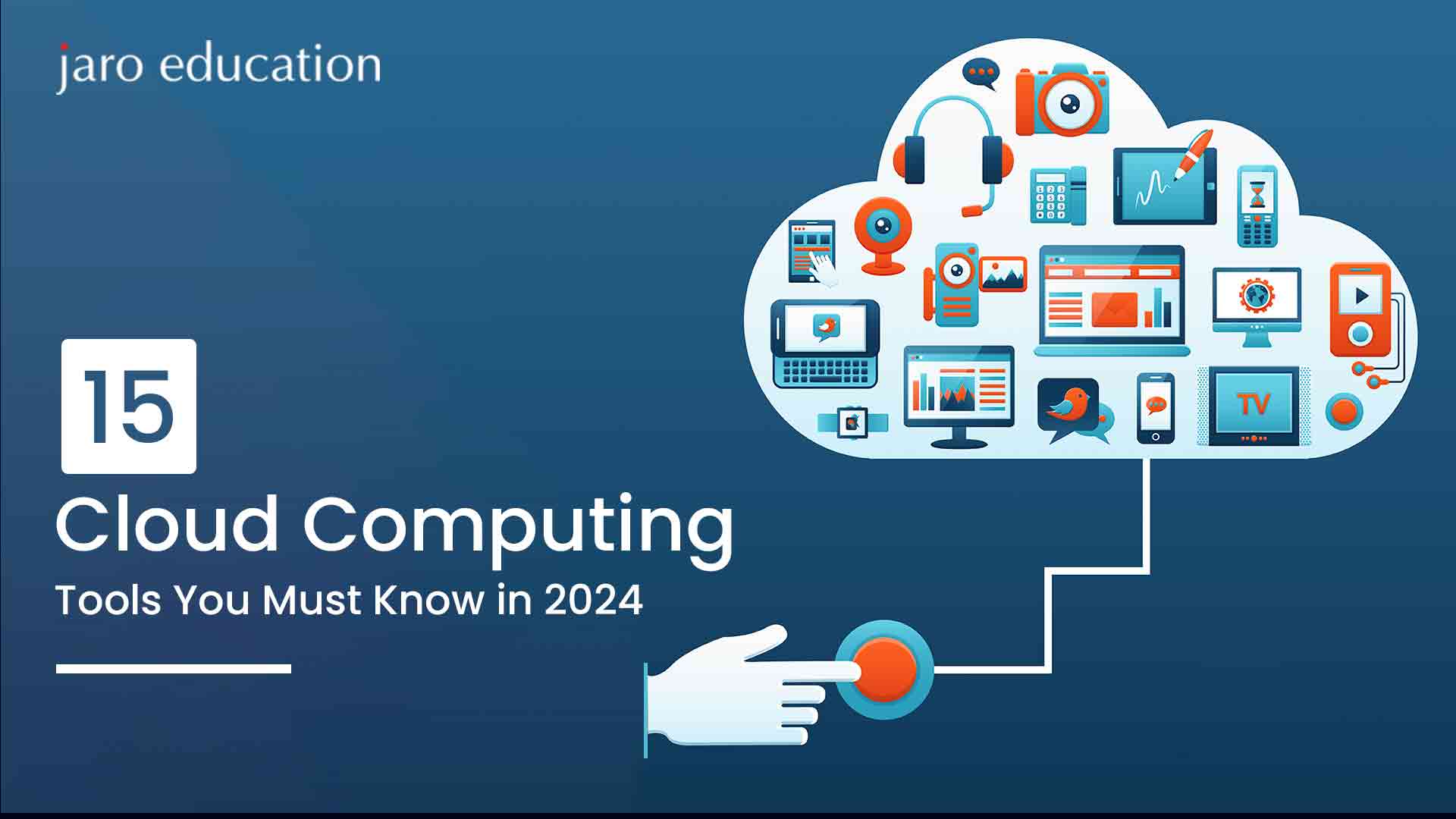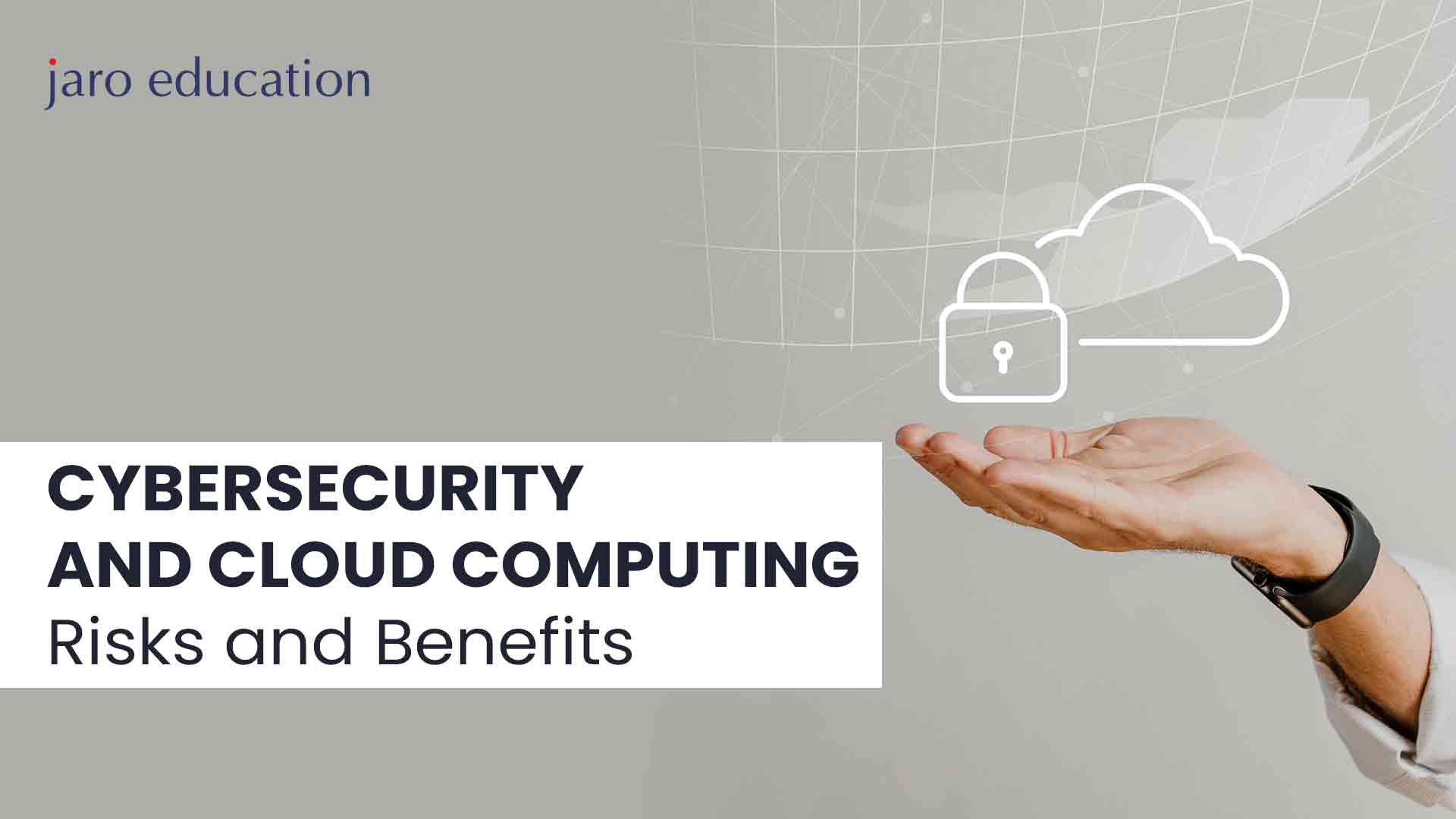29 Internet of Things Examples You Should Know
Table of Contents
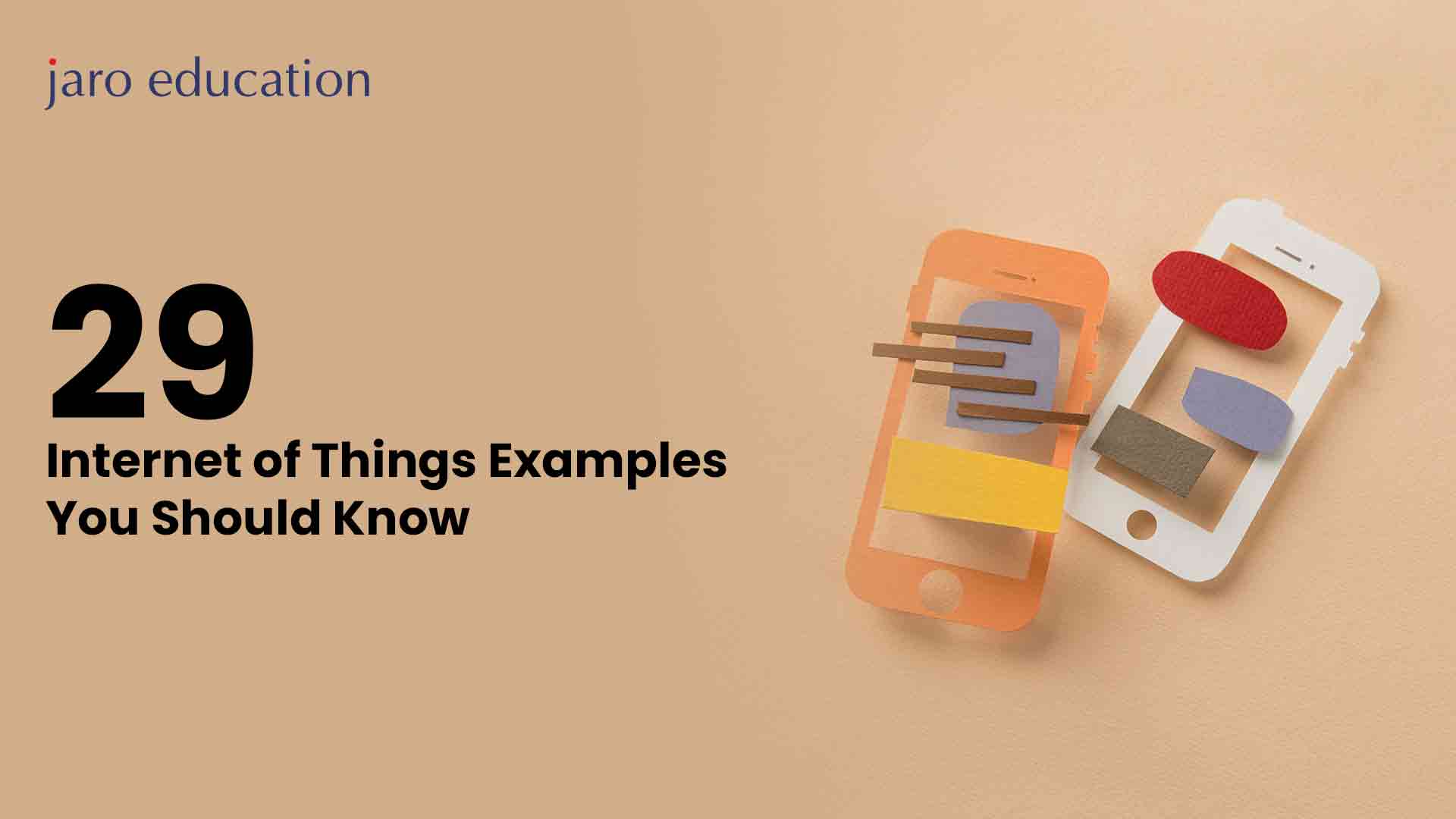
- jaro education
- 14, April 2024
- 2:00 pm
The Internet of Things, commonly known as IoT, has emerged as a transformative force, reshaping the way the world interacts with things digitally. Smart cars, gears, dog collars, etc., have become common in everyday use. Tech giants have already begun predicting the future of IoT as consumers will depend more on such devices. These sensors work smarter than humans and don’t need human intervention. IoT has many things to offer to everyone. Those who want to know the examples and features of IoT should read this guide.
What is the Internet of Things?
The Internet of Things is a revolutionary concept of interconnected networks. This network consists of physical devices, vehicles, appliances, and other objects embedded with sensors and software. These devices can collect and exchange data, creating a seamless and intelligent web of information.
At its core, IoT enables devices to communicate and share data. This leads to increased automation, efficiency, and convenience in our daily lives. The concept is not limited to traditional computing devices but extends to a wide range of objects, from household appliances to industrial machinery.
One key aspect of IoT is the ability of devices to gather real-time data through sensors. These sensors can monitor and measure various parameters such as temperature, humidity, motion, etc. This data is then transmitted through the internet, allowing for remote monitoring and control.
In the home, IoT applications are transforming the way we live. Smart thermostats, lighting systems, and security cameras are just a few examples of how IoT is enhancing comfort and security. Through interconnected devices, users can remotely manage their homes, adjust settings, and receive smartphone alerts.
Transformative Features of IoT
The Internet of Things (IoT) has emerged as a revolutionary technological paradigm, reshaping the way we interact with our surroundings. Let’s delve into the key features that make IoT a transformative force in the digital landscape.
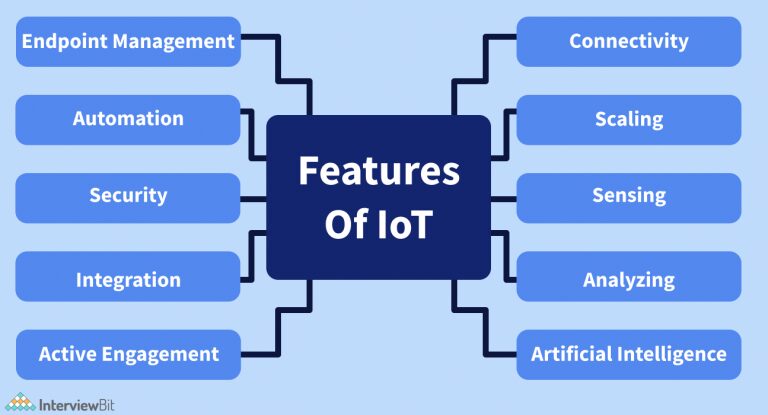
1. Connectivity and Interoperability
At the heart of IoT lies the seamless connectivity between devices. Using sensors and communication protocols, IoT enables devices to interact and share data in real-time. Interoperability, the ability of diverse devices and systems to work together, ensures a unified ecosystem, fostering collaboration and data exchange among different IoT devices.
2. Data Collection and Analysis
IoT devices generate an immense volume of data through various sensors and actuators. This data serves as a valuable resource for businesses, researchers, and individuals. The ability to collect, process, and analyse this data provides insights that can be used for informed decision-making, predictive maintenance, and optimisation of processes.
3. Automation and Control
IoT empowers automation by allowing devices to communicate and make decisions based on real-time data. Smart homes, industrial automation, and autonomous vehicles are just a few examples of how IoT facilitates intelligent control systems, enhancing efficiency and minimising human intervention.
4. Security and Privacy
As the number of connected devices grows, robust security measures become paramount. IoT devices often handle sensitive data, and vulnerabilities can pose serious risks. Features like end-to-end encryption, secure authentication, and regular software updates play a crucial role in safeguarding user privacy and IoT systems’ integrity.
5. Scalability
One of the standout features of IoT is its scalability. IoT solutions can scale to meet the environment’s specific needs, whether deployed in a small-scale smart home or an extensive industrial network. This scalability ensures flexibility, making IoT applicable across diverse industries and settings.
6. Energy Efficiency
IoT devices are designed with energy efficiency in mind, optimising resource usage and prolonging battery life. This feature is particularly crucial for devices in remote locations or those powered by renewable energy sources. IoT contributes to sustainability goals by minimising energy consumption and reducing environmental impact.
7. Real-time Monitoring and Feedback
IoT enables real-time monitoring of processes and environments, providing instant feedback that can be used to respond promptly to changing conditions. This is evident in applications such as healthcare monitoring, where wearable devices transmit vital signs for immediate analysis and intervention if necessary.
8. Predictive Maintenance
IoT devices’ ability to continuously monitor equipment performance enables predictive maintenance. By analysing data patterns, IoT systems can predict when machinery or devices are likely to fail, allowing for proactive maintenance and minimising downtime.
29 Internet of Things Examples and Applications
The Internet of Things (IoT) has rapidly transformed the way we interact with the world around us. IoT devices seamlessly integrate into our daily lives, from smart homes to industrial applications. Let’s delve into 29 examples that showcase IoT’s versatility and impact.
1. Building Connection and Security
Property owners utilise IoT to upgrade buildings for improved energy efficiency, comfort, convenience, and safety. IoT monitors HVAC systems in real-time in commercial settings, adjusting temperatures for optimal efficiency and comfort. AI-driven cameras aid in crowd management, ensuring smooth traffic flow and enhancing public safety during events.
2. Connected Devices
IoT encompasses many connected devices, from smartphones and smartwatches to household appliances and industrial machinery. These devices are equipped with sensors, processors, and communication hardware, enabling them to gather and exchange data seamlessly.
3. Data Collection and Analysis
IoT devices gather data from their surroundings, facilitating real-time analysis to derive meaningful insights for decision-making. This data aggregation encompasses a wide range of parameters, including environmental conditions, user behaviour, and system performance metrics.
4. Wireless Communication Protocols
Wireless protocols like Wi-Fi, Bluetooth, Zigbee, and RFID enable seamless communication between IoT devices. Each protocol serves specific purposes and operates within distinct frequency bands, catering to diverse connectivity, range, and power consumption requirements.
5. Security Challenges
IoT security concerns include data privacy, unauthorised access, and the potential for cyberattacks on interconnected systems. Concerns arise due to sensitive data collected, the potential for unauthorised entry, and vulnerabilities in networked devices. Mitigation strategies include encryption, secure authentication, and ongoing monitoring to safeguard against threats and ensure the integrity of IoT deployments.
6. Edge Computing
Edge computing involves processing data closer to the source, reducing latency and enhancing the efficiency of IoT applications. Unlike traditional cloud computing, which involves transmitting data to centralised servers for analysis and processing, edge computing distributes computational tasks to local devices or “edge nodes” closer to where data is generated.
7. Cloud Integration
Many IoT solutions leverage cloud platforms for data storage, analysis, and scalability. By leveraging cloud platforms, IoT devices can efficiently transmit data to remote servers for storage and processing, enabling real-time insights and robust analytics.
8. Artificial Intelligence in IoT
9. IoT in Healthcare
IoT applications in healthcare include remote patient monitoring, smart medical devices, and data-driven treatment plans. Remote monitoring allows continuous tracking of vital signs, while smart devices offer real-time health data. Data analytics personalise treatments, improving outcomes.
10. Smart Cities
IoT is pivotal in creating smart cities by optimising infrastructure, transportation, and energy management. Through interconnected devices and sensors, cities can enhance efficiency, reduce traffic congestion, monitor energy usage, and improve the overall quality of life for residents.
11. Industrial IoT (IIoT)
IIoT revolutionises industries by enhancing operational efficiency, predictive maintenance, and overall productivity. IIoT optimises processes, minimises downtime, and enables data-driven decision-making, transforming traditional manufacturing and industrial operations through interconnected analytics and sensors.
12. IoT Standards
Standardisation efforts ensure interoperability and compatibility among different IoT devices and platforms. y establishing common protocols and specifications, IoT standards streamline communication, facilitate seamless integration, and promote the scalability and sustainability of interconnected ecosystems.
13. 5G Connectivity
The rollout of 5G networks accelerates IoT adoption, providing faster and more reliable communication. With enhanced bandwidth and lower latency, 5G enables real-time data transmission, supports massive device connectivity, and unlocks new possibilities for innovative IoT applications across various industries and domains.
14. Energy Efficiency
IoT technologies contribute to energy conservation through smart grids, smart buildings, and optimised resource management. This enhances efficiency for a more sustainable energy ecosystem.
15. IoT in Agriculture
IoT is transforming agriculture through precision farming, smart irrigation, and livestock monitoring. These innovations optimise resource usage, enhance crop yields, and improve animal welfare, ushering in a new era of sustainable and efficient farming practices.
16. Privacy Concerns
Balancing the benefits of IoT with individual privacy is a critical challenge, requiring robust regulations and ethical considerations. Striking the right balance ensures that technological advancements uphold privacy rights while harnessing the benefits of IoT innovation.
17. Blockchain in IoT
Blockchain technology enhances security and transparency in IoT applications by providing a decentralised and tamper-resistant ledger. This ensures data integrity, mitigates the risk of unauthorised access, and fosters trust among stakeholders in interconnected ecosystems.
18. Consumer IoT Devices
Smart home devices, wearables, and connected cars represent the growing market of consumer-focused IoT applications. These innovations enhance convenience, personalisation, and connectivity,
19. Predictive Maintenance
IoT enables industry predictive maintenance by monitoring equipment health and predicting potential failures. This proactive approach minimises downtime, reduces maintenance costs, and ensures optimal performance of critical assets.
20. Environmental Monitoring
IoT sensors help monitor environmental conditions, contributing to climate research and disaster prevention. This data aids in climate research facilitates disaster prevention efforts and promotes sustainable practices for preserving ecosystems and protecting public health.
21. Regulatory Compliance
Compliance with regulatory frameworks and industry standards is paramount to uphold the ethical and responsible integration of IoT technologies, safeguarding data privacy, security, and consumer rights while fostering trust and sustainability in the evolving digital landscape.
22. Supply Chain Optimisation
IoT enhances supply chain visibility, tracking goods from production to delivery and optimising logistics processes. Compliance promotes data privacy, cybersecurity, and consumer protection, fostering trust and accountability in the development and implementation of IoT solutions.
23. Human-machine interaction
IoT devices are increasingly designed to understand and respond to human behaviour, fostering a more intuitive and seamless user experience. The evolution has made smoother interactions, personalised services, and greater convenience across various IoT applications and domains possible.
24. Economic Impact
The widespread adoption of IoT has significant economic implications, driving innovation, job creation, and economic growth, thus fundamentally reshaping global markets and economies.
25. Cross-Industry Collaboration
Facilitating collaboration among diverse industries and stakeholders is imperative to tackle shared hurdles and cultivate groundbreaking innovation within the Internet of Things ecosystem, driving synergistic solutions and unlocking unprecedented potential across sectors worldwide.
26. Data Ownership
In IoT discussions, who owns and controls data is crucial. Users want transparency and control over their personal information, emphasising the need for clear rules to protect privacy and digital rights.
27. Social Impact
The Internet of Things (IoT) harbours the potential to tackle pressing societal issues like improving healthcare accessibility, enhancing environmental preservation efforts, and bolstering disaster response mechanisms
28. Ethical Considerations
Ethical considerations within IoT development encompass ensuring fairness, accountability, and transparency in data and technology utilisation, emphasising the paramount importance of ethical frameworks to uphold societal trust and integrity in digital innovation.
29. Continuous Evolution
IoT is a dynamic field that continues to evolve, with ongoing advancements shaping the future of interconnected technologies. It promises an ever-changing landscape that drives innovation and reshapes the future of interconnected systems and their impact on society.
Advantages of IoT Transforming Connectivity
The Internet of Things brings myriad advantages that span across various industries, shaping the way we live, work, and interact with our surroundings.
Benefits of IoT
- Use of Smart Devices
- Achieve Customer-Centricity
- Reduction in Operational Cost
- Collects Rich Data
- Enhances Security Measures
1. Efficiency and Automation
IoT empowers automation by connecting devices and systems, enabling streamlined processes and increased efficiency. From smart homes to industrial settings, automation not only reduces human intervention but also enhances precision and productivity.
2. Data Insights for Informed Decision-Making
The vast amount of data generated by IoT devices provides valuable insights. Businesses and industries can leverage this data to make informed decisions, optimise operations, and identify trends, ultimately fostering innovation and competitiveness.
3. Improved Quality of Life
In the realm of healthcare, wearable devices and IoT-enabled medical equipment are transforming patient care. Continuous monitoring, early detection of health issues, and remote patient management contribute to an improved quality of life and more efficient healthcare services.
4. Smart Cities for Sustainable Living
IoT plays a pivotal role in the development of smart cities. Connected infrastructure, such as smart traffic lights, waste management systems, and energy-efficient buildings, enhances urban living by reducing congestion, minimising environmental impact, and promoting sustainability.
5. Enhanced Security and Safety
IoT strengthens security measures by providing real-time monitoring and alerts. From smart home security systems to industrial surveillance, IoT-enabled devices offer proactive solutions, preventing and mitigating potential threats.
6. Optimised Resource Management
Industries can optimise resource utilisation through IoT. Agricultural IoT applications, for instance, facilitate precision farming by monitoring soil conditions, weather patterns, and crop health, leading to more sustainable and productive agriculture.
7. Supply Chain Visibility
The integration of IoT in supply chain management offers end-to-end visibility. Tracking the movement of goods in real-time, monitoring conditions such as temperature and humidity, and predicting maintenance needs contribute to a more efficient and transparent supply chain.
8. Energy Efficiency and Conservation
IoT contributes to energy conservation through smart grids and connected devices. Intelligent energy management systems optimise consumption, reduce waste, and pave the way for a more sustainable future.
9. Personalised Experiences
IoT enables the creation of personalised experiences in various domains. From retail to entertainment, connected devices can tailor services based on user preferences, providing a more customised and enjoyable user experience.
10. Economic Growth and Job Creation
The widespread adoption of IoT technologies fosters economic growth by creating new business opportunities and generating jobs. Industries embracing IoT solutions contribute to technological advancements and innovation, driving economic prosperity.
The Future of IoT: Transforming Industries and Enhancing Lives
The Internet of Things (IoT) has already made significant strides in connecting devices and enabling seamless communication between them. As we look towards the future, the trajectory of IoT promises to revolutionise industries, reshape daily life, and bring about unprecedented advancements.
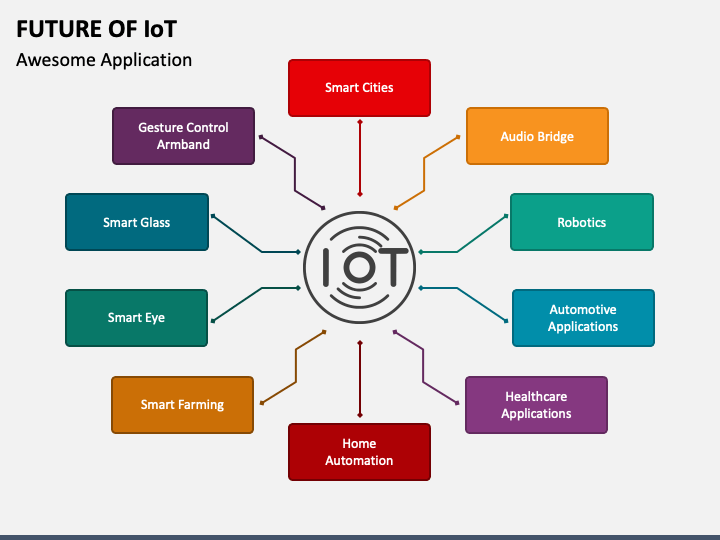
1. Massive Connectivity and 5G Integration
With the rollout of 5G networks, IoT devices will experience a significant boost in connectivity. This ultra-fast and low-latency network will enable more devices to be connected simultaneously, paving the way for more sophisticated applications in smart cities, autonomous vehicles, and industrial settings.
2. Edge Computing for Real-time Processing
The rise of edge computing will address the challenge of processing vast amounts of data generated by IoT devices. By performing data processing closer to the source (at the edge of the network), edge computing reduces latency, enhances efficiency, and enables real-time decision-making.
3. AI and Machine Learning Integration
As IoT devices generate enormous datasets, integrating artificial intelligence (AI) and machine learning (ML) will become pivotal. Smart devices will leverage these technologies for data analysis, predictive maintenance, and personalised user experiences.
4. Enhanced Security Measures
With the proliferation of connected devices, security becomes a paramount concern. Future IoT solutions will incorporate advanced encryption, biometric authentication, and blockchain technology to ensure the integrity and confidentiality of data.
5. Cross-Industry Collaboration
The future of IoT lies in the collaboration between industries. Integration between healthcare, transportation, energy, and other sectors will create synergies that lead to more comprehensive and efficient solutions. For example, healthcare IoT devices could seamlessly communicate with transportation systems to enhance emergency medical services.
6. Sustainable IoT Practices
The environmental impact of IoT will be a focus in the future. Sustainable practices, such as energy-efficient devices, eco-friendly materials, and responsible manufacturing, will shape the development of IoT technologies.
7. Healthcare Revolution
IoT’s impact on healthcare will continue to evolve, with remote patient monitoring, personalised treatment plans, and predictive healthcare becoming more prevalent. Wearable devices and smart implants will provide continuous health data, allowing for proactive healthcare interventions.
8. Autonomous Vehicles and Smart Transportation
IoT will be pivotal in developing autonomous vehicles and smart transportation systems. Connected vehicles communicating with traffic signals, other cars, and infrastructure will enhance road safety, reduce traffic congestion, and optimise transportation networks.
9. Augmented Reality (AR) and Virtual Reality (VR) Integration
IoT will converge with AR and VR technologies, creating immersive and interactive experiences. This fusion will have training, education, gaming, and remote collaboration applications.
10. Smart Buildings and Cities
The concept of smart cities will mature with interconnected systems managing energy consumption, waste management, traffic flow, and public services. Smart buildings will utilise IoT for efficient resource utilisation and enhanced occupant comfort.
Conclusion
The future of IoT is poised for groundbreaking advancements that will reshape how we live, work, and interact with our surroundings. As technology evolves, integrating IoT with 5G, AI, edge computing, and other emerging technologies will unlock unprecedented possibilities, creating a more connected and intelligent world. It is an exciting era of innovation, where the Internet of Things is set to become an integral part of our daily lives, driving progress and transforming industries across the globe.
And given its emergence in everyday life, professionals can leverage the most out of it. This is why IIM Indore offers an Executive Programme in Cyber Security for Organizations [EPCSO] to IT professionals and students. This programme is helpful in many ways as IoT evolves and advances and paves a progressive path for mankind.
Recent Blogs
It seems we can't find what you're looking for.


